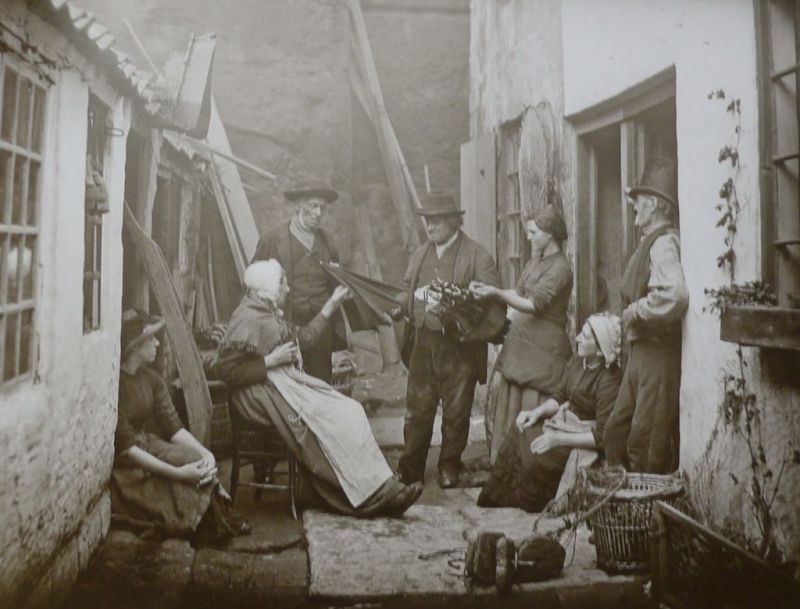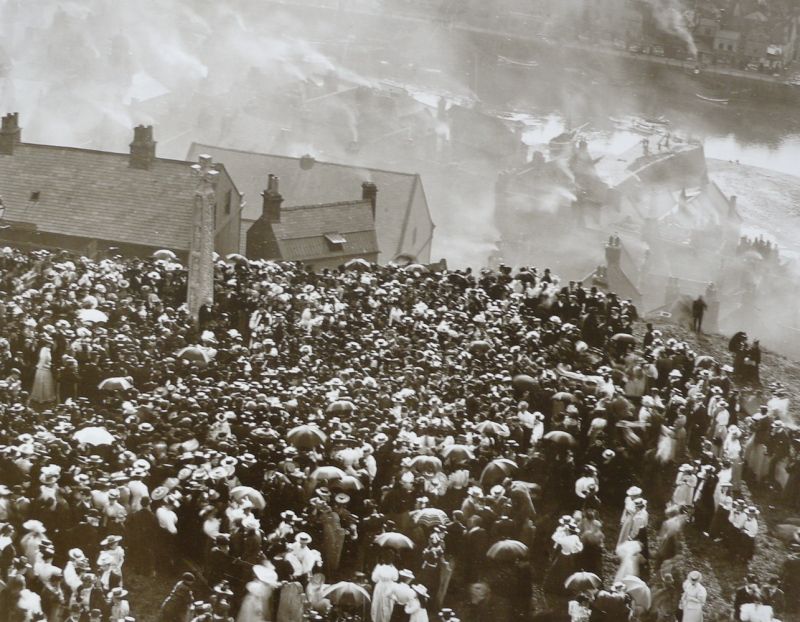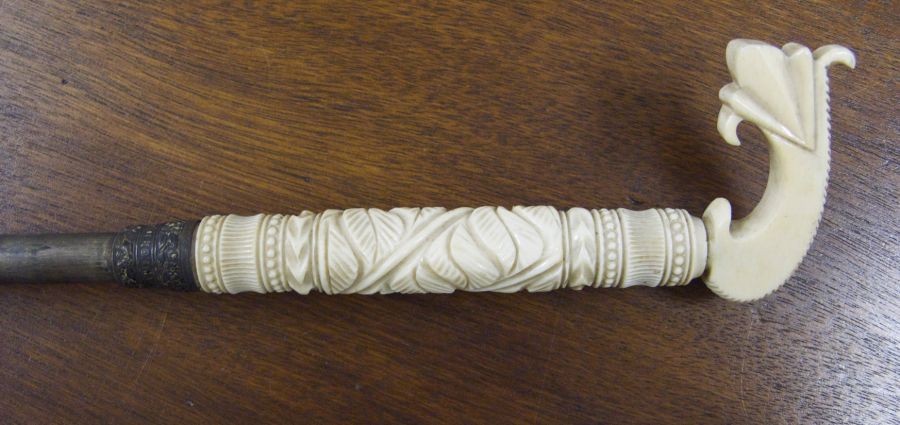ikfoundation.org
The IK Foundation
Promoting Natural & Cultural History
Since 1988


VICTORIAN AND EDWARDIAN UMBRELLAS
– a Case Study
Umbrellas for protection in the rain and parasols for the sun – here a few examples of the first mentioned will be looked at more closely, from the small coastal town of Whitby during the Victorian and Edwardian periods. These umbrellas can be studied via advertisements in the weekly newspaper Whitby Gazette, as well as two local photographs and preserved models from the Whitby Museum, illustrating this useful item from different perspectives. The umbrellas were made of silk or cotton of various qualities, mainly depending on each and everyone's taste and financial circumstances.
 “The Umbrella Seller” from the 1870s. This staged photograph depicts one of the yards in the eastern part of old Whitby, if the group of people were just admiring the umbrellas or someone actually made a purchase from the travelling salesman is hard to know. (Photo: Frank Meadow Sutcliffe).
“The Umbrella Seller” from the 1870s. This staged photograph depicts one of the yards in the eastern part of old Whitby, if the group of people were just admiring the umbrellas or someone actually made a purchase from the travelling salesman is hard to know. (Photo: Frank Meadow Sutcliffe).Edmund Crane’s Linen and Woollen Drapers, apparently the largest such local firm in mid-19th century, advertised continually in the early years of Whitby Gazette. The shop had a rich stock to offer its customers, mainly clothing and accessories for clothes but also textiles for home furnishing. On 27 July 1855, Crane listed ‘umbrellas’ among many other wares.
Henry Duck was in business as a General Draper at 9 Flowergate and regularly had small advertisements in the Whitby Gazette. In the spring of 1870, he announced ‘a Large Display of New Goods in his Extended Premises’ not only with the usual drapery items but every imaginable accessory for women’s clothing: ‘Crinolines, Sunshades, Umbrellas…’ As well as in December of 1882 when he, among many articles, mentioned ‘the Best Umbrellas’. Around the same time, W. Thornton’s at the Old Market Place repeatedly announced: ‘Prepare for a Rainy Day, Home-made Umbrellas – the Largest Stock of Home-made Umbrellas’. Additionally, in the same advert: ’Umbrellas made to order, Re-covered or Repaired on the Shortest Notice' (May 26, 1877).
An example from the 1890s is the firm of Lambert & Warters of Manchester House, Fishburn Park. They advertised regularly, selling both clothes and home furnishings, for example, on 30 March 1893 when everything was described as ‘New’: ‘Jackets, Capes, Dresses, Skirts, Corsets, Umbrellas…’ and much more.
 This photograph taken by Frank Meadow Sutcliffe from the church tower of Whitby Parish church, gives a rare opportunity to catch a glimpse of the use of umbrellas on a drizzling and smoggy day. The occasion can be dated exactly to 21st September 1898 when the Caedmon Cross was unveiled. (Photo: Frank Meadow Sutcliffe).
This photograph taken by Frank Meadow Sutcliffe from the church tower of Whitby Parish church, gives a rare opportunity to catch a glimpse of the use of umbrellas on a drizzling and smoggy day. The occasion can be dated exactly to 21st September 1898 when the Caedmon Cross was unveiled. (Photo: Frank Meadow Sutcliffe).The Whitby Museum Costume Collection includes quite a number of parasols, but just a few umbrellas that can be dated from before 1914. It must, however, be stated that there sometimes is an obvious resemblance between the parasols/umbrellas, and some models may have had double uses. Additionally, one can suppose that umbrellas were often used until worn out – not as dependent on fashion trends as parasols – and were, therefore, seldom donated to a museum collection.
Three models in the collection can be classified as umbrellas; two of these are late Victorian in style, whilst the third is Edwardian with unbleached cotton and open-work machine embroidery. The two earlier umbrellas are both in brown silk, including a very expensive specimen (GBZ 58) in silk brocade with an inner lining of matching brown silk, and a heavily ornamented ivory handle – illustrated here below – that matches a similarly designed top. Its metal cover is marked ‘28 Cheapside Crawford’, indicating the umbrella & parasol manufacturer by the name of Crawford with a business address at 28 Cheapside, London. The firm was already established by 1829, when it appeared in The Register of Arts, and Journal of Patent Inventions. At what time this umbrella ended up in Whitby is unknown.
 Close-up of the ornamented ivory handle, notice that the ivory top and handle may be older than the rest of the umbrella which dates to the late Victorian period. It was probably common to re-use the frames, tops and handles – particularly if these parts were of expensive types – when the worn fabric was replaced with a new cloth. (Whitby Museum, Costume Collection, GBZ 58). Photo: Viveka Hansen.
Close-up of the ornamented ivory handle, notice that the ivory top and handle may be older than the rest of the umbrella which dates to the late Victorian period. It was probably common to re-use the frames, tops and handles – particularly if these parts were of expensive types – when the worn fabric was replaced with a new cloth. (Whitby Museum, Costume Collection, GBZ 58). Photo: Viveka Hansen.Sources:
- Hansen, Viveka, The Textile History of Whitby 1700-1914 – A lively coastal town between the North Sea and North York Moors, London & Whitby 2015 (Chapter III & pp. 259-60).
- Whitby Gazette, 1855-1900 (Whitby Museum, Library & Archive).
- Whitby Museum, Costume Collection (research of umbrellas and parasols).
More in Books & Art:
Essays
The iTEXTILIS is a division of The IK Workshop Society – a global and unique forum for all those interested in Natural & Cultural History from a textile Perspective.
Open Access essays, licensed under Creative Commons and freely accessible, by Textile historian Viveka Hansen, aim to integrate her current research, printed monographs, and earlier projects dating back to the late 1980s. Some essays feature rare archive material originally published in other languages, now available in English for the first time, revealing aspects of history that were previously little known outside northern European countries. Her work also explores various topics, including the textile trade, material culture, cloth manufacturing, fashion, natural dyeing, and the intriguing world of early travelling naturalists – such as the "Linnaean network" – viewed through a global historical lens.
For regular updates and to fully utilise iTEXTILIS' features, we recommend subscribing to our newsletter, iMESSENGER.
been copied to your clipboard




– a truly European organisation since 1988
Legal issues | Forget me | and much more...
You are welcome to use the information and knowledge from
The IK Workshop Society, as long as you follow a few simple rules.
LEARN MORE & I AGREE







